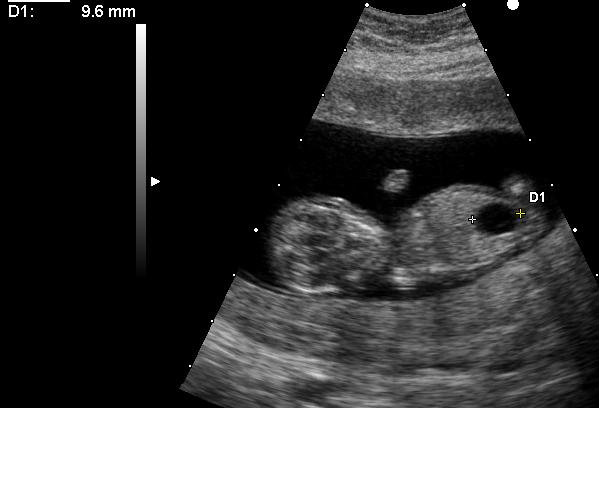Duodenal atresia screening
Jump to navigation
Jump to search
|
Duodenal Atresia Microchapters |
|
Diagnosis |
|---|
|
Treatment |
|
Case Studies |
|
Duodenal atresia screening On the Web |
|
American Roentgen Ray Society Images of Duodenal atresia screening |
|
Risk calculators and risk factors for Duodenal atresia screening |
Editor-In-Chief: C. Michael Gibson, M.S., M.D. [1]; Associate Editor(s)-in-Chief: Hamid Qazi, MD, BSc [2]
Overview
There is insufficient evidence to recommend routine screening for duodenal atresia. However, screening for down syndrome may show duodenal atresia during pregnancy.
Screening
- There is insufficient evidence to recommend routine screening for duodenal atresia.
Down Syndrome Screening
Screening for down syndrome is as follows:[1][2][3][4][5][6]
- Genetic counseling is usually offered to families who may have an increased chance of having a child with Down syndrome along with:
- genetic testing
- amniocentesis
- Involves inserting instruments into the uterus which carry a small risk of causing fetal injury.
- chorionic villus sampling (CVS)
- Involves inserting instruments into the uterus which carry a small risk of causing fetal injury.
- Percutaneous umbilical blood sampling (PUBS) are usually offered
- Common screening procedures for Down syndrome are given in Table 1.
| Screen | When performed (weeks gestation) | Detection rate | False positive rate | Description |
|---|---|---|---|---|
| Triple screen | 15–20 | 75% | 8.5% | This test measures the maternal serum alpha feto protein (a fetal liver protein), estriol (a pregnancy hormone), and human chorionic gonadotropin (hCG, a pregnancy hormone).[7] |
| Quad screen | 15–20 | 79% | 7.5% | This test measures the maternal serum alpha feto protein (a fetal liver protein), estriol (a pregnancy hormone), human chorionic gonadotropin (hCG, a pregnancy hormone), and high inhibin-Alpha (INHA).[7] |
| AFP/free beta screen | 13–22 | 80% | 2.8% | This test measures the alpha feto protein, produced by the fetus, and free beta hCG, produced by the placenta. |
| Nuchal translucency/free beta/PAPPA screen | 10–13.5 | 91%[8] | 5%[8] | Uses ultrasound to measure Nuchal Translucency in addition to the freeBeta hCG and PAPPA (pregnancy-associated plasma protein A). NIH has confirmed that this first trimester test is more accurate than second trimester screening methods.[9] |

References
- ↑ Eddleman, Keith A.; et al. (2006). "Pregnancy loss rates after midtrimester amniocentesis". Obstet Gynecol. 108 (5): 1067–1072. Retrieved 2006-12-09. PMID 17077226
- ↑ Caroline Mansfield, Suellen Hopfer, Theresa M. Marteau (1999). "Termination rates after prenatal diagnosis of Down syndrome, spina bifida, anencephaly, and Turner and Klinefelter syndromes: a systematic literature review". Prenatal Diagnosis. 19 (9): 808–812. PMID 10521836 This is similar to 90% results found by David W. Britt, Samantha T. Risinger, Virginia Miller, Mary K. Mans, Eric L. Krivchenia, Mark I. Evans (1999). "Determinants of parental decisions after the prenatal diagnosis of Down syndrome: Bringing in context". American Journal of Medical Genetics. 93 (5): 410–416. PMID 10951466
- ↑ Fackler, A. "Down syndrome". Retrieved 2006-09-07.
- ↑ Will, George (2005-04-14). "Eugenics By Abortion: Is perfection an entitlement?". Washington Post: A37. Retrieved 2006-07-03.
- ↑ Erik Parens and Adrienne Asch (2003). "Disability rights critique of prenatal genetic testing: Reflections and recommendations". Mental Retardation and Developmental Disabilities Research Reviews. 9 (1): 40–47. Retrieved 2006-07-03. PMID 12587137
- ↑ Glover, NM and Glover, SJ (1996). "Ethical and legal issues regarding selective abortion of fetuses with Down syndrome". Ment. Retard. 34 (4): 207–214. PMID 8828339.
- ↑ 7.0 7.1 For a current estimate of rates, see Benn, PA, J Ying, T Beazoglou, JFX Egan. "Estimates for the sensitivity and false-positive rates for second trimester serum screening for Down syndrome and trisomy 18 with adjustments for cross-identification and double-positive results". Prenatal Diagnosis. 21 (1): 46–51. PMID 11180240
- ↑ 8.0 8.1 Some practices report adding Nasal Bone measurements and increasing the detection rate to 95% with a 2% False Positive Rate.
- ↑ NIH FASTER study (NEJM 2005 (353):2001). See also J.L. Simplson's editorial (NEJM 2005 (353):19).